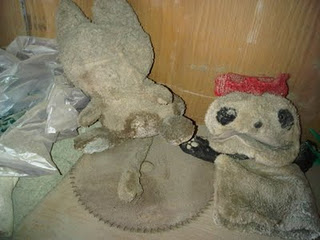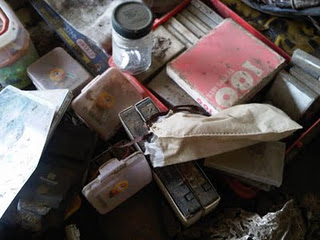Report from
the Event at Tsuyama Gymnasium (Evacuation centre for those from Minamisanriku)
A computer screen at the Tsuyama Gymnasium evacuation
centre. Five different locations
are shown on one screen.
On 24 July, we held a “Women’s Communication
Space” event. (Sponsored by Miyagi Jonet and the Miyagi Prefecture Female Diet
Members of the Volunteer Executive Committee)
The idea was to let women talk about their
experiences of the earthquake and tsunami disaster.
We used Skype conference to connect us in the
meeting room of a hotel at Sendai Station with the participating women in
Iwate, Miyagi and Fukushima.
I participated in the event, driving staff
members to an evacuation centre in Tome city (Miyagi Prefecture).
In the first months after the disaster as many as
300 refugees from Minamisanriku were living in this gymnasium in the Tsuyamacho
Yanaizu district of Tome City.
More than four months after the disaster struck,
many people have left the gymnasium to return to their repaired homes, to move
into temporary housing, rented apartments, and other locations. But 80 people
still live in the gymnasium. At
this location, the refugees received absolutely no emergency supplies from the
Japan Self-Defense forces, but managed themselves to prepare three meals a day.
Each time, they made rice in two pots, one measuring
3 sho (5.4L) and the other measuring 5 sho (9L). One pot’s worth of rice was
used to make 60 onigiri rice balls every single day for the people working to
remove rubble and for those going to jobs. According to S-san, who was in
charge of managing the rations, “It was really difficult! But at least we had
something to do then, and that made us happy. It gave us the confidence to
carry on.”
Another person in the refuge is T-san, who is a
public health nurse from Minamisanriku. Even though her home and family members
were victims of the disaster, she took it upon herself to see to the health of
the refugees, from children to the elderly. She made the meaningful
observation: “I’m not sure that it’s a good thing for those of us living in the
refuge to always be on the receiving end of support. How will it affect our
strength to survive?”
From the live-casting point
in Ichinoseki City, we were joint by the refugees from the disaster area of Rikuzentakata.
The headquarters of the
soy sauce manufacturer they worked for was destroyed, but no one was fired –
not one person. Instead, they were relocated to the company’s branch in Ichinoseki,
and all of them continue to work there. They appealed to us: “We are developing
new products. We will continue doing our best, so please give us your support!”
From the Onagawa evacuation
centre: Here a 70-year-old woman gives pep talks to the local administration on
behalf of the women and handicapped people at the refuge site, and also makes
the rounds of people living alone in temporary housing to provide
encouragement. “Everybody wants to do
something. Women want to work with their hands. We need sewing machines. We’d
also like irons, and fabric and other materials,” she said.
A young single mother from Koriyama City in
Fukushima told us: “There is the threat of radiation. I am worried about the
future of my children. I want to be told what the actual situation is every
day. I’m building contacts over the Internet,” she reported.
At the Sendai event site, there were 150
participants from the surrounding areas. On the computer screen, five windows were
displayed alternately.
Many people gathered around in the event site.
Diet members, prefectural assembly members, city councilors, and even a movie
director from New York spoke to the many residents there. A female reporter
from Sri Lanka also gave a speech.
Comments from people providing support across the
nation were heard, as well as the views of a survivor from Ishinomaki who was
hard hit by the disaster.
Even though the time available was short,
everyone made the most of it.
“There is a definite imbalance in how goods are
distributed.
‘We don’t have enough milk! Where is it?’ ‘There is some in XX, we’ll send it.’
‘Fall is approaching. We don’t have enough
blankets.’ ‘They must have some in
XX, we’ll check.’
‘We would like sewing materials and sewing
machines.’ ‘There are support organizations – we’ll contact them immediately.’
‘We can’t just continue to accept aid
indefinitely, we want to work. Please help us to find jobs!’ ‘Let’s petition
the local administration! Lets make our voices heard, and prepare some concrete
plans!’
Ahh, there just isn’t enough time!
But this is a start.
Everyone was very excited – “Let’s continue to
transmit the voices of real women!!”
As the windows showing women in other locations
closed one by one, applause filled the event hall, and a feeling of relief
swept over the women there.
It was then that I realized something.
When people entered or left the refuge site hall,
they were careful not to make any noise. In addition, they gave staff members
and speakers at the event large servings from their emergency rice supplies.
M-san, a local volunteer worker, came to the first
Jonet Salon held in May.
Midwives working in the disaster-hit area also
participated.
We received words of thanks from so many people!
And then we returned to Sendai.
Written that day in Tome City by Staff Member M






























































